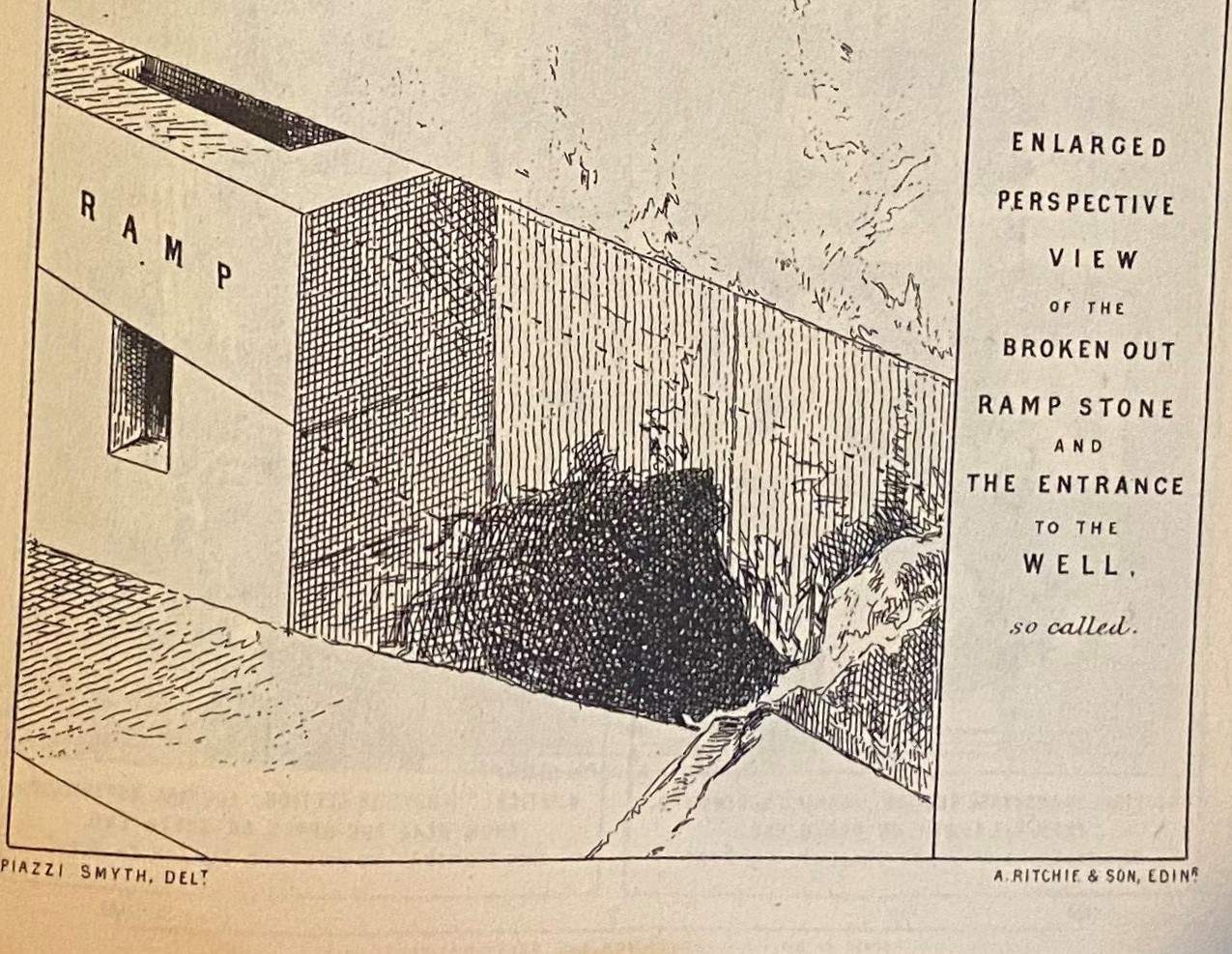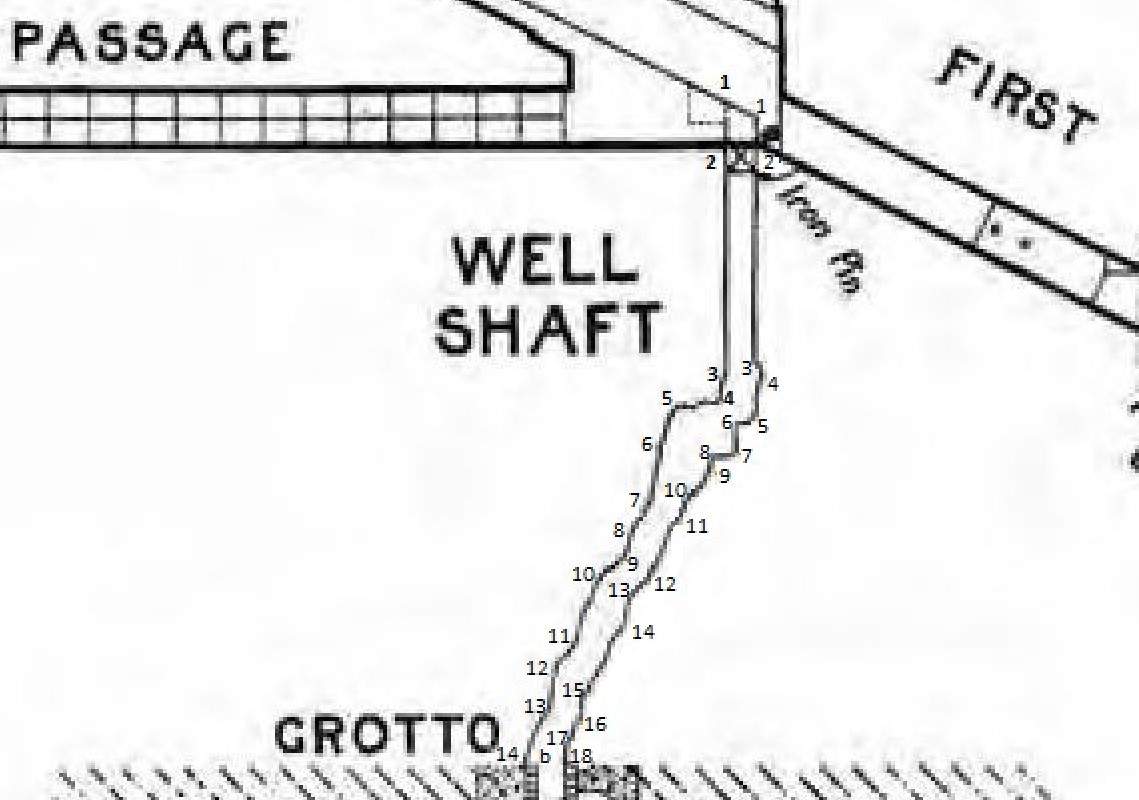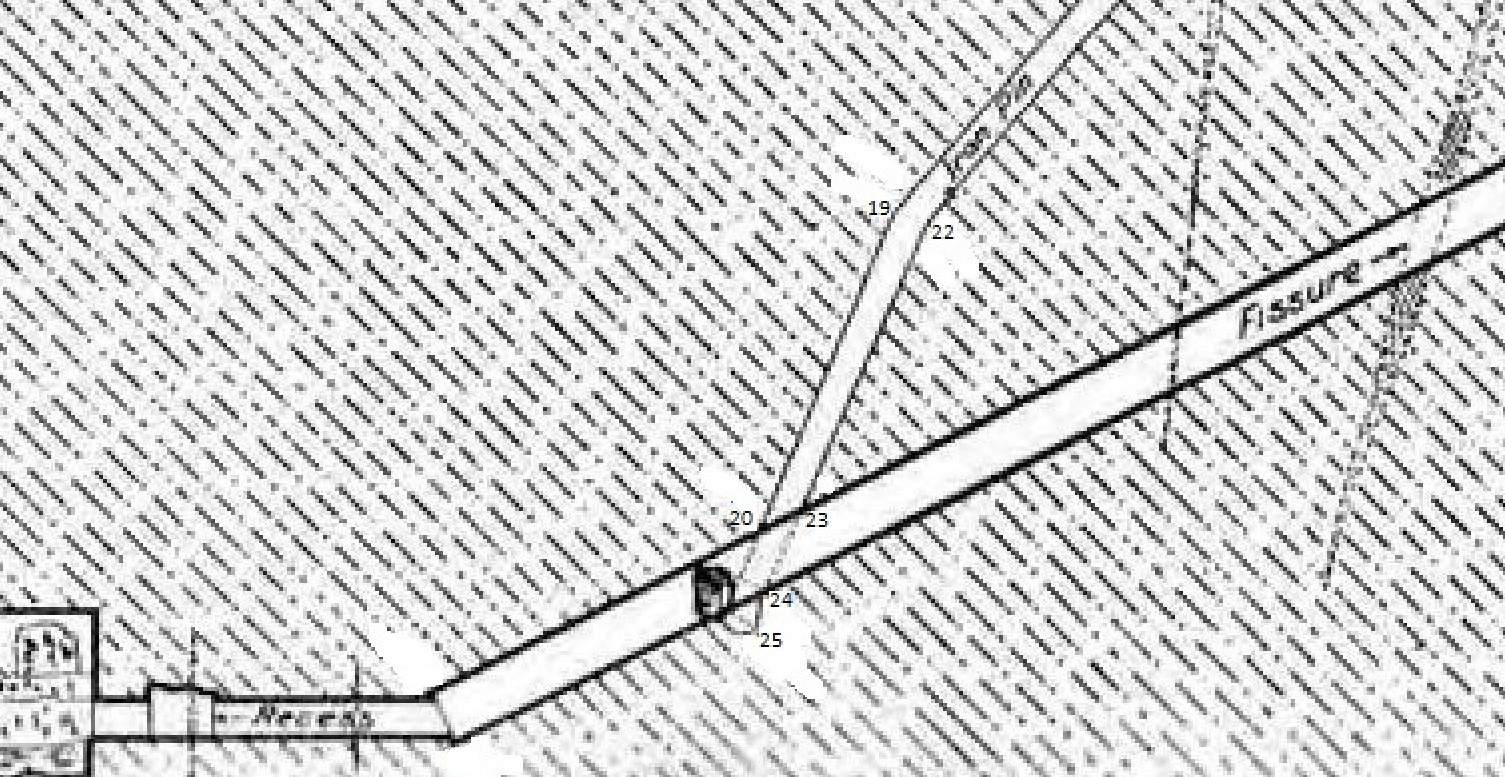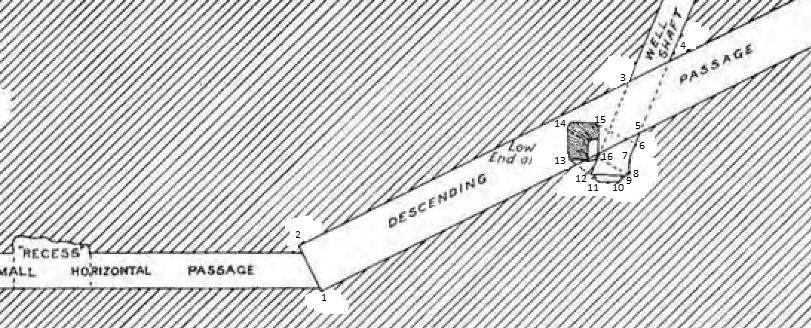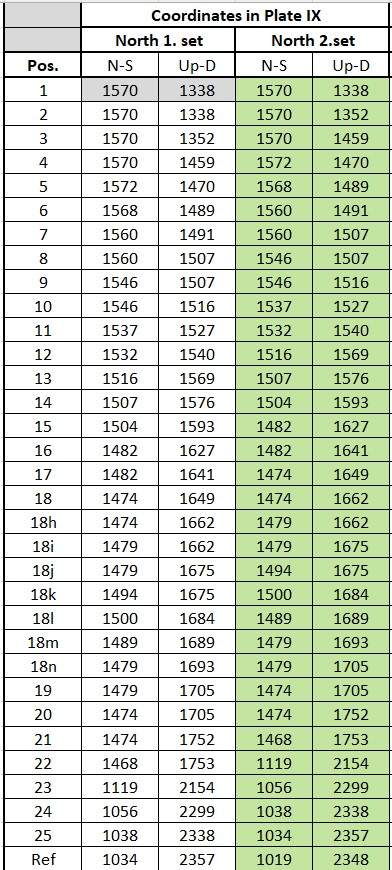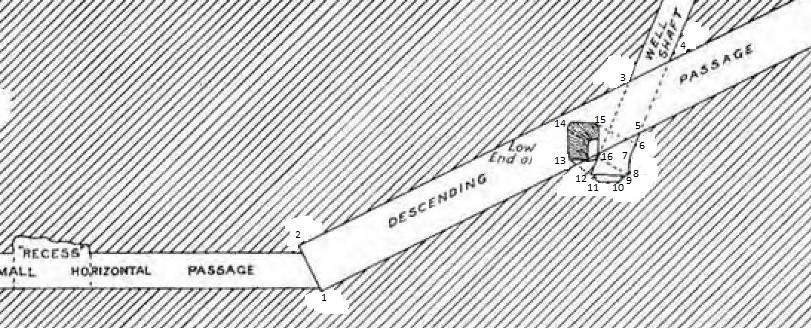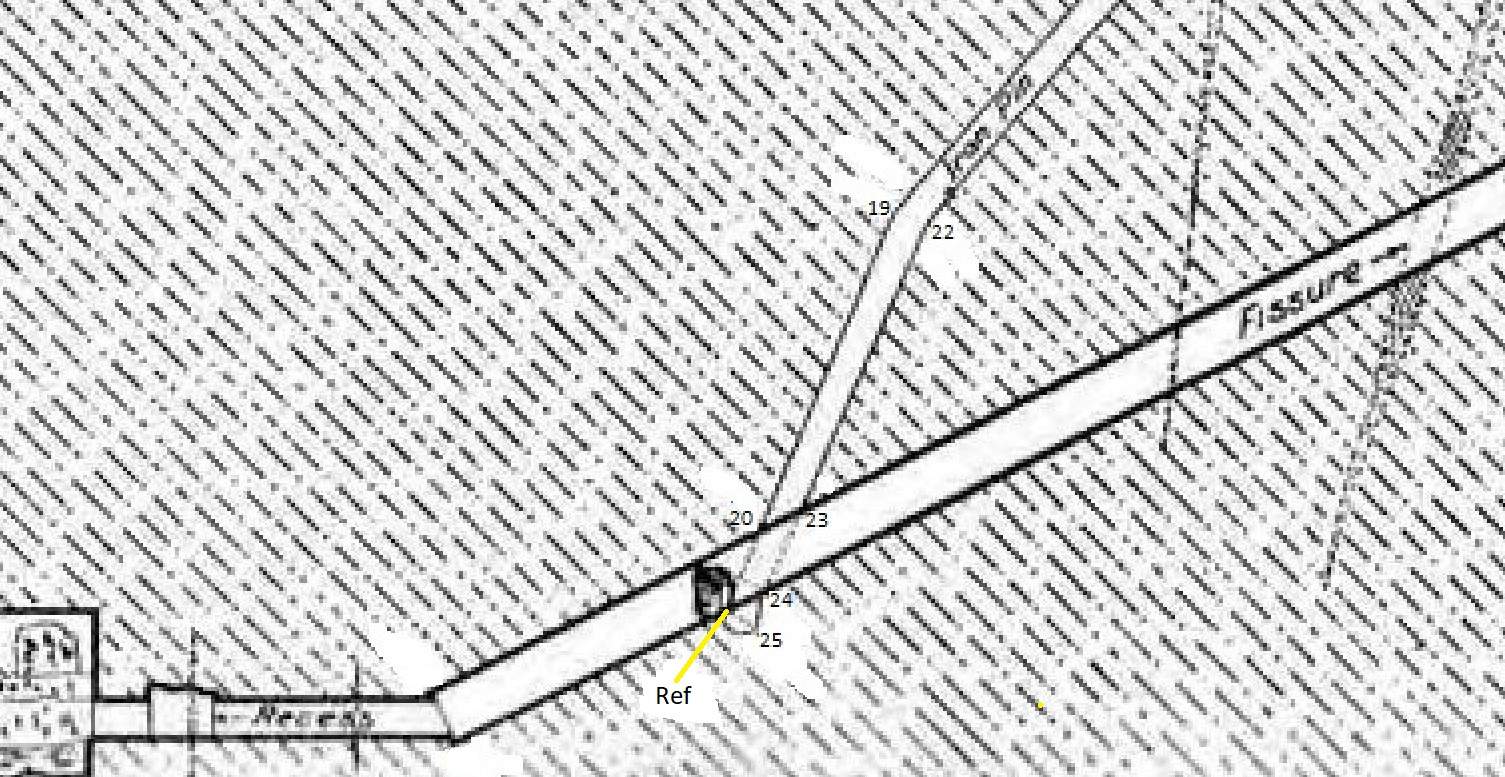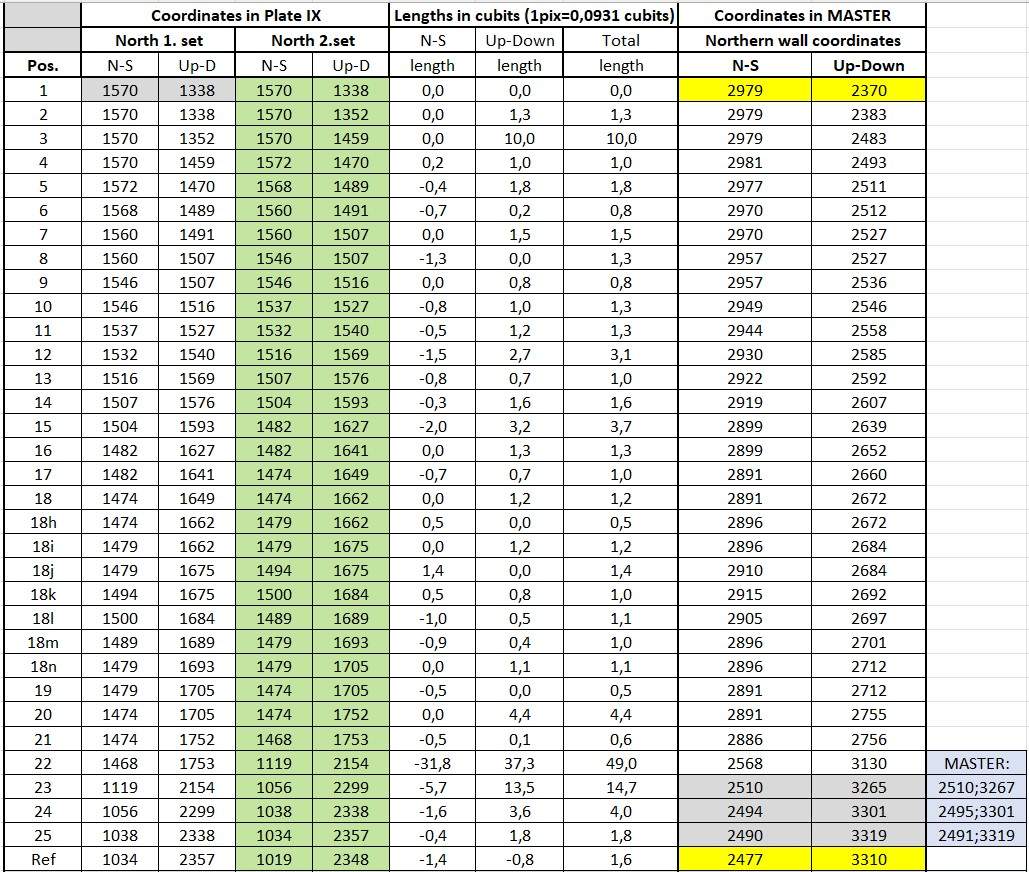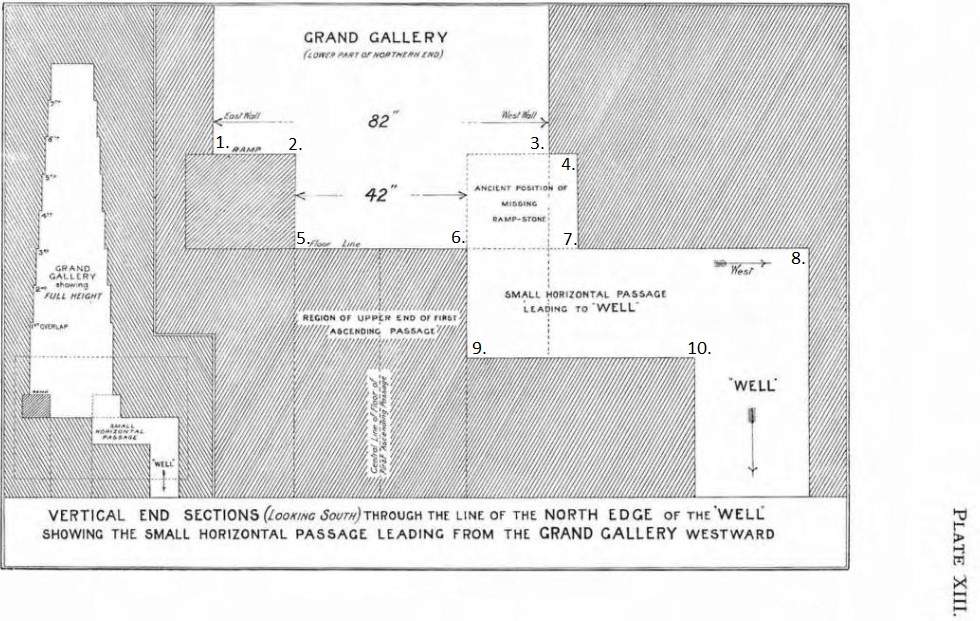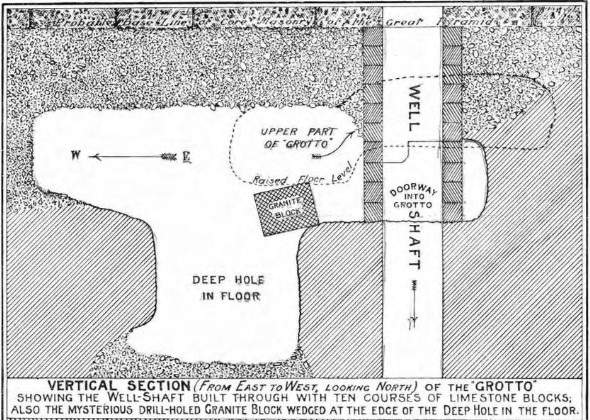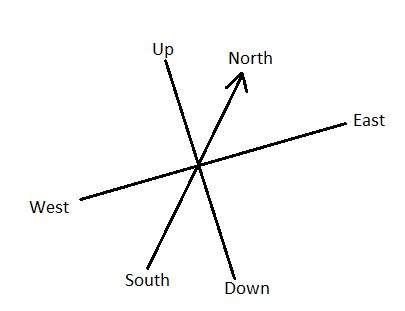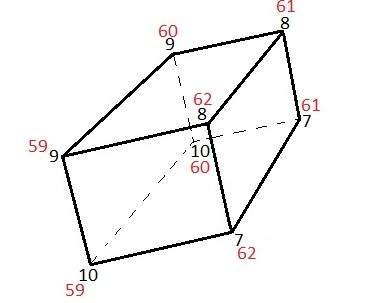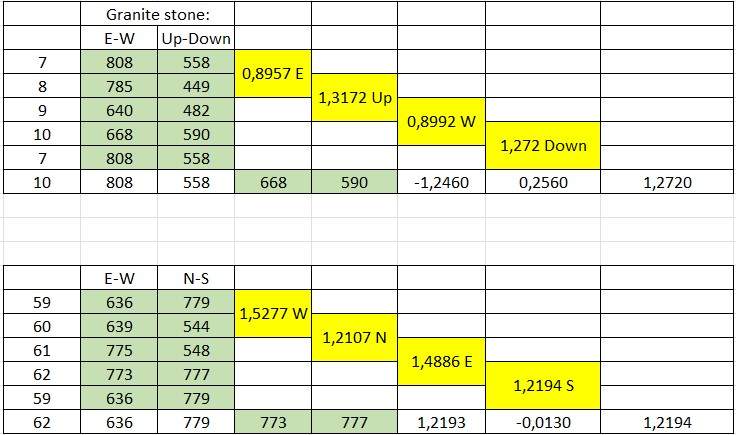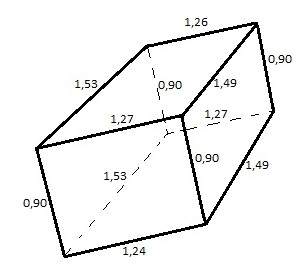The Shaft or Well
Section 5.6.1
From the North-West corner of the Grand Gallery is a peculiar passageway called the "shaft" or "well shaft" consisting of different passages hereunder a so called "grotto".
The purpose of the passageway is still unknown and a mystery is connected to it, read more in section 5.5.5
Piazzi Smyth mentioned following:
"Something may come of that, in the hands of future explorers; but meanwhile we have to notice another feature, and a most important one, already established or brought to light by the removal of part of the rampstonein the lower north-west corner of the Grand Gallery, for the removal of that mass just there, long ago disclosed a constructional secret of the original builders, viz. a rather small and low West-going outlet, leading to the upper end of a very deep and solemn kind of shaft, usually called "the well", in the annals of early Pyramid exploration.
At those times nothing was known of the Pyramid´s Entrance-passage further down its course than its junction with Caliph Al Mamoun´s forced hole and the entry to the first ascending passage. Therefore, when men ventured to look into the well-mouth from close to the north-western corner of the Grand Gallery, near the broken ramp-stone as above, they found themselves overhanging a dark and dismal abyss, no one knew how deep or where leading to.
What Caliph Al Mamoun and his immediate followers thought of it, is not recorded; but soon after his time, "the well" begins to figure in Arab accounts, as an open pit of preternatural depth and fearful qualities. A party of twenty men, from the Faioum district, was once formed to investigate the mystery, but was frightened by one of their number falling down the aperture such a terrible distance, that he was said to have been three hours in the act of falling."
(S21-P453-L21 to P454-L17)
Piazzi Smyth continued:
"Again, at a later age, the celebrated Cambridge traveller, Dr. Clarke, visited the place with a large military party, and on throwing a stone in the well, and hearing it end by splashing, as they all considered, thrusting to their fallacious ears, in water, - he called impressive attention to the admirable truth and perfect faithfulness of classic authors; for had Pliny duly written that there was a water-well in the Great Pyramid, 80 cubits deep ?
Again, in 1818, Signor Caviglia cleared out the entrance-passage of the Great Pyramid thoughout the whole distance right down to the deep subterranean chamber; and lo, near the bottom of it, on the western side, was a low doorway leading into a dark passage: by pushing into which, and following its lead, and clambering in the darkness higher and higher, and yet higher, or 170 feet vertical altogether, he at length found himself at the same well-mouth where Dr. Clarke had dropped in the deceiving stone, and entering the lower north-west corner of the Grand Gallery. Very thirsty, too, as well as hot and tired was he, for not a particle of water existed in any portion of the so-called well; the whole of which, including the lower end of the entrance-passage anhd the subterranean chamber, is far above the level of the Nile inundation, the only source of water in that scorched and almost rainless land."
(S21-P454-L25 to P455-L15)
My comments:
There are two interesting aspects in his story:
When Signor Caviglia in 1818 cleared
out the entrance-passage, the doorway into the west wall appeared, so in 1818 the doorway was not closed or sealed. Perhaps it never was. For a long period of time the descending passageway has been filled up with sand, gravel and dirt and might be the reason Caliph Al Mamoun´s men did not discover the the lower part of the well.
Another point is the story about Dr. Clarke, when he dropped the stone into the well, he clearly heard a splash. Let us assume the lower part of the well was filled up and the grotto in the well originally was an underground source of water; the grotto is surrounded by lose gravel and it is well known there is water here and there under the dry surface of the plateau, then it could be possible a certain amount of water was captured in the shaft. If so, the story might be true.
Piazzi Smyth continued:
"Perhaps they did. But in case let us ask, "In what state would they left the ramp-stone over the well´s mouth?"
Certainly not blown from within outwards, as if by uncontrolled explosive force, breaking off part of the wall with it, and leaving the hole´s mouth exposed; for that would have defeated theit whole project. They would, on the contrary, have contrived a temporary support for the stone when in a position impending over the hole, partly in the floor and partly in the wall; or a support such, that when the last man had come away, the prop, would be easily withdrawn, and the stone would fall neatly into a seat already cut for it, and cemented round the edges with freshly applied lime to make the work permanent and secure. For then such stone would be flush with the rest of the ramp, and would utterly conceal from any one who should ever enter the Grand Gallery by the regular method of th first ascending passage, that there was any well-mouth whatever behind the surface of the ramp.
The original builders, then, were not those who knocked out, from within on the well side, that now lost ramp-stone, and exposed the inlet to the well-mouth as it is presently seen, near the north-west cornerof the Grand Gallery. Neither was Al Mamoun the party, for no one could have done it except by entering the well from the very bottommost depths of the subterranean region; and he, the son of Caliph Harun Al Raschid, and all his crew, did not descend further down the entrance-passage than merely to the level of his own forced hole, which is not subterranean at all. Nor is the credit claimed for any of his Arab successors, who rather allude to the well as an already existing feature in their earliest time, and one they did not understand; in large part, too, because they had only seen, and only knew of, the upper end of it in the north-west corner of the Grand Gallery floor; and there it was simply a deep hole, the beginning of darkness and the shadow of death.
Who then did burst out that now missing ramp-stone?
Who indeed ! For the whole band of Egyptological writers we have mentioned, appear to be convinced that ages before Caliph Al Mamoun made his way by blundering and smashing, - long ages, too, before Mohammed was born, and rather at and about the period of Judah being carried captive to Babylon, - the Egyptians themselves had entered the Great Pyramid by cunning art and tolerable understanding of its mere methods of construction; and had closed it again when they left. "
(S21-P455-L30 to P457-L6)My comments:
Please look at the drawing of Piazzi Smyth underneath.
It seems not only one stone, but two stones are missing; and the upper stone, the ramp-stone, was partly underneath the western wall and a lower stone which touched the floor.
Source: S21, The Great Pyramid of Piazzi Smyth plate XII
In section 5.5.5 there is a drawing of Edgar showing exactly the same.
How were the stones removed and why? It is still a mystery.
Section 5.6.2
Edgar made two drawings of the passageway (plate IX and plate X), but only few measurements are revealed in my sources. This is the reason I measured his drawings and added position numbers.
Source: The Great Pyramid Passages And Chambers" Volume 1 by John and Morton Edgar, 1910 (modified plate IX)
Closer view on the upper part:
Source: The Great Pyramid Passages And Chambers" Volume 1 by John and Morton Edgar, 1910 (modified plate IX)
Closer view on the mid part:
Source: The Great Pyramid Passages And Chambers" Volume 1 by John and Morton Edgar, 1910 (modified plate IX)
Closer view on the lowest part:
Source: The Great Pyramid Passages And Chambers" Volume 1 by John and Morton Edgar, 1910 (modified plate IX)
Section 5.6.3
Another drawing plate X of Edgar added positions:
Source: The Great Pyramid Passages And Chambers" Volume 1 by John and Morton Edgar, 1910 (modified plate X)
A closer view:
Source: The Great Pyramid Passages And Chambers" Volume 1 by John and Morton Edgar, 1910 (modified plate X)
Section 5.6.4
As a lot of measuring data are missing, I have another way to determine the coordinates in the shaft:- Determine the scale of the different drawings.
- Find reference coordinates in the top (Grand Gallery) and in the bottom of the shaft (the doorway in the descending passageway).
- Read the coordinates on the different drawings using the program Paint.
- Convert the drawing coordinates to the MASTER drawing coordinates by calculations.
- As I am not sure Edgars angle between the descending passageway and ascending passageway in the overall drawing is exactly the same as mine (or Petries), but differs a little bit, then I assume the N-S coordinates are correct and the up-down coordinates will be corrected if nescessary as a function of the MASTER coordinate lines.
Section 5.6.5
I added two coordinates in the drawing mentioned in section 5.5.6, 2379;2370 and 2979;2384 into the drawing underneath.The two reference coordinates for the upper part is marked with a blue pen, 2966;2364 and 2979;2370
Section 5.6.6
The top coordinates 2966;2364 and 2979;2370 works as the upper references in the plate IX drawing and reads 1554;1331 and 1570; 1338 respectively.If I read all other postions in plate IX, then I will get these coordinates on the south side of shaft in the columns "South 2. set",:
(The columns "South 1. set" function as part the calculations later on).
The coordinates on the northen side reads:
The point "Ref" will be explained in section 5.6.7.
Section 5.6.7
Please focus on the other drawing plate X from section 5.6.3:
Source: The Great Pyramid Passages And Chambers" Volume 1 by John and Morton Edgar, 1910 (modified plate X)
We know two reference points, 1 and 2.
The coordinate for point 1 in plate X reads 960;314 and the similar coordinate in the MASTER drawing is
2349;3373.
Section 5.6.8
The conversion factor between the coordinates in plate X and the MASTER drawing was found in the full size plate X:
Source: The Great Pyramid Passages And Chambers" Volume 1 by John and Morton Edgar, 1910 (modified plate X)
The width of the subterranean chamber is 592 pixels - 248 pixels = 344 pixels, which is 15,81 cubits RM according to section 5.3.17.
The conversion factor is 15,81 cubits / 344 pixels = 0,0459593 cubits/pixel.
From the above readings we can calculate all the MASTER drawing coordinates:
The coordinates marked blue are readings from the MASTER drawing. The only diversion is point 2, here is the calculated coordinate 2339;3352 but the N-S part of the Up-Down coordinate reads 3353 in the MASTER drawing. If there are any minor diversions, then I take the coordinate from the MASTER drawing.
Point 16, marked yellow, where the imaginary line of the southern side hits the floor of the descending passageway is the point "Ref" as mentioned above.
The coodinate in point 16 is important for the calculations of the MASTER coordinates in plate IX.
Calculation method:
Section 5.6.9
We return to plate IX in section 5.6.2:
Source: The Great Pyramid Passages And Chambers" Volume 1 by John and Morton Edgar, 1910 (modified plate X)
The coordinates of the northern part of the shaft are as follows:
I have inserted the upper MASTER coordinate 2979;2370 reference and the reference coordinate 2477;3310 in the table. To hit both figures in the reference coordinate there are two different factors, one for the N-S coordinates and the other for the Up-Down coordinates. The reason for this might be a little difference between the plate IX drawing and the MASTER drawing.
The N-S factor is determined to be: 0,09115 by iteration.The Up-Down factor is determined to be: 0,0931 by iteration.
The blue marked coordinates overrule the calculated values.
Calculation method:
The coordinates in the MASTER drawing for the southern side are:
Calculation method:
Section 5.6.10
The coordinates in the Grotto are found in a similar way.The markings in the Grotto:
Source: The Great Pyramid Passages And Chambers" Volume 1 by John and Morton Edgar, 1910 (modified plate CL)
I have inserted the upper MASTER coordinate 2112;2672 reference in the table. To hit both figures in the reference coordinate there are two different factors, one for the East - West coordinates and the other for the Up-Down coordinates. The reason for this might be a little difference between the plate X drawing and the MASTER drawing.
The E-W factor is determined to be: 0,0089 by iteration.The Up-Down factor is determined to be: 0,0080 by iteration.
The blue marked coordinates overrule the calculated values.
Calculation method:
Section 5.6.11
Let us focus on the East- West direction.Petrie seems to accept the measurements which are done by Smyth:
"Distance East side, to West side of well mouth, .. = 28,0"
(Source: S21-P71-L31)
My comments:
28" = 1,36 cubits RM
"Depth within wall, from which ramp-stone to close Well mouth, has been broken out, .... = 7,0"
"Horizontal length of Western passage to Well mouth, from East side of hole in floor to West side of Well, = 84,5"
"Do. do. do. East do. = 56,0"
"Do. from East side of acting roof to West side of Well, = 57,0"
"Depth of hole in floor, . . . . . . = 27,0"
"Depth of roofed portion of horizontal passage to Well mouth, . . . . . . = 27,0"
My comments:
7" = 0,34 cubits RM
84,5" = 4,1 cubits RM
56,0" = 2,72 cubits RM
57,0" = 2,76 cubits RM
27,0" = 1,31 cubits RM
(Source: S21-P71-L34-L40)
Section 5.6.12
Let us compare these measures with the drawing of Edgar.
Source: The Great Pyramid Passages And Chambers" Volume 1 by John and Morton Edgar, 1910 (modified plate XIII)
I have added numbers to certain corners. The coordinates for the corners are listed here:
I have inserted the upper MASTER coordinate 2041;2375 reference in the table. To hit both figures in the reference coordinate there are two different factors, one for the E-W coordinates and the other for the Up-Down coordinates. The reason for this might be a little difference between the plate X drawing and the MASTER drawing.
The Up-Down factor is determined to be: 0,0106 by iteration.
The blue marked coordinates overrule the calculated values.
Calculation method:
Section 5.6.13
Source: The Great Pyramid Passages And Chambers" Volume 1 by John and Morton Edgar, 1910 (modified plate XIII)
The measures in the column "Edgars drw." are taken from the above table in section 5.6.12. I have added columns for the measures by Petrie and Smyth as well for comparaison.
I assume the drawing of Edgar in Plate XIII show the East-West construction, when you look southwards, but the drawing shows the northern part of the hole and the Well Shaft.Nearly all distances in Edgars drawing in Plate XIII seems to be OK. .
But, the distances E, F and I in Edgars drawing deviate from the measurements. Let us investigate how they deviate.
Distances E and F : "Vertical height of the ramp-bench", which is the height from the floor to the northen top of the hole where the ramp-bench was, is not 1,01 cubits according to Edgar. The height of the ramp-benches perpendicular to the ramp floor, or the offset, is 1,0 cubit RM according to Petrie.
The vertical height is therefore
1 / cos 26,2139° = 1,1 cubits. (Se more details in section 5.5.6)
Distance "Not shown" : "Vertical height of the missing part of the ramp-bench", which is
the height from the floor to the southen part of the hole on the top of the ramp-bench. According to the drawing of Edgar this height is not shown, but it gives us the impression it is the same height. It is 2 cubits.
(Se more details in section 5.6.5)
Distance I : "Depth of the hole in the floor", Smyth has measured this depth to 1,31 cubits RM , according to the drawing of Edgar it is only 1,16 cubits. You may claim the deviation is very small, yes it is, but it is significant.
Section 5.6.14
As Edgars drawing is very fine and more or less correct I have added the MASTER East-West; Up-Down coordinates into his drawing:Source: The Great Pyramid Passages And Chambers" Volume 1 by John and Morton Edgar, 1910 (modified plate XIII)
Section 5.6.15
Seen from above the mouth of the Well Shaft is shown with red lines, the vertical part is marked grey:Section 5.6.16
The East -West, North West coordinates of the Grotto can be found from Edgars drawing:Source: The Great Pyramid Passages And Chambers" Volume 1 by John and Morton Edgar, 1910 (modified plate CL)
The readings and the MASTER coordinates are as follows:
I have inserted the upper MASTER coordinate 2098;2880 reference in the table. To hit both figures in the reference coordinate there are two different factors, one for the East - West coordinates and the other for the North-South coordinates. The reason for this might be a little difference between the plate X drawing and the MASTER drawing.
The E-W factor is determined to be: 0,0089 by iteration.The Up-Down factor is determined to be: 0,0065 by iteration.
Calculation method:
Section 5.6.17
Updated Master drawing:Section 5.6.18
The Mystery of The Granite Block in The GrottoIn the drawing in section 5.6.10 you can see a peculiar granite block on an edge of a deep hole.
Source: The Great Pyramid Passages And Chambers" Volume 1 by John and Morton Edgar, 1910
Why is it there and where did it come from?
First of all we need to figure out how it looks like. From the drawings in section 5.6.10 and 5.6.15 we can calculate the dimensions.
Here are parts of the drawings showing the granite block with numbers marked yellow in the corners:Source: The Great Pyramid Passages And Chambers" Volume 1 by John and Morton Edgar, 1910 (modified plate CL) . From section 5.6.10
Source: The Great Pyramid Passages And Chambers" Volume 1 by John and Morton Edgar, 1910 (modified plate CL) . From section 5.6.16
I have tried to draw the granite block seen from an angle, so all sides are shown:
West is to the left, East is to the right, North is pointing away from you and South is pointing against you.
Then numbers from the two drawings are added:
From the tables in the same sections I have made a little overview which shows where the corners are in the drawings and calculated the distances between the corners.
The calculations are the same as above in the respective sections.
Then all the lengths in cubits are added to my drawing:
The volume is approximately:
Height: (0,90+0,90+0,90+0,90)/4 = 0,90 cubits x 0,5236 meters/cubits = 0,47 meters
Width: (1,26+1,27+1,24+1,27)/4 = 1,26 cubits x 0,5236 meters/cubits = 0,66 meters
Length: (1,53+1,49+1,49+1,53)/4 = 1,51 cubits x 0,5236 meters/cubits = 0,79 meters
Volume : 0,47m x 0,66m x 0,79m = 0,25m3The approximately weight is:
The density of granite is according to Wikipedia (https://en.wikipedia.org/wiki/Granite) between 2,65 g/cm3 and 2,75 g/cm3 or 2650 kg/m3 and 2750 kg/cm3.
I have chosen an average of (2650 kg/m3 + 2750 kg/m3)/2 = 2700 kg/m3
0,25 m3 x 2700 kg/m3 = 675 kg, (but the range is from 663 kg to 688 kg)
So, a granite block of a approximately 675 kg has ended up in a Grotto under the masonry - why and how?
